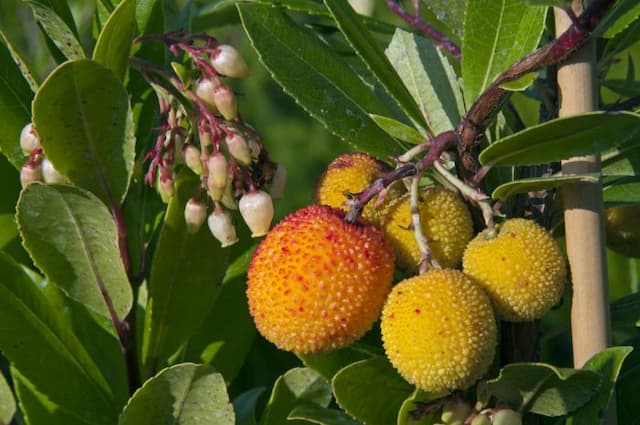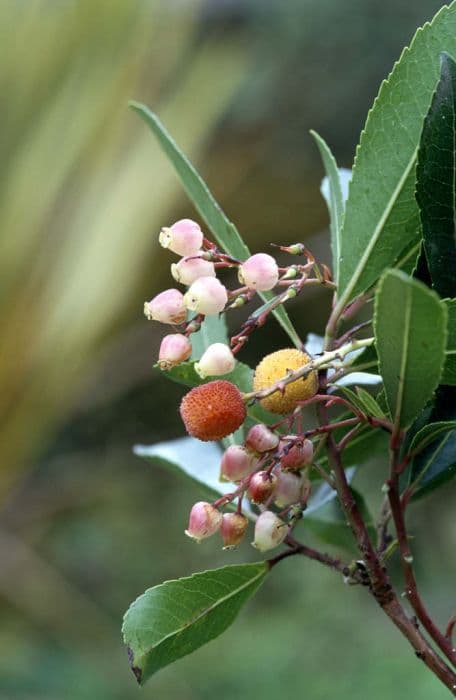Wintergreen 'Mulberry Wine' Gaultheria mucronata 'Mulberry Wine' (f)

ABOUT
'Mulberry Wine' is a small, suckering evergreen shrub forming a dense thicket, with small, spiny, dark green leaves. Flowers small, white, in early summer; fruits magenta-purple, deepening with age
About this plant
 Names
NamesFamily
Ericaceae.
Synonyms
Prickly Heath, Prickly Chilean Guava, Prickly Guava, Spiky Chilean Guava, Muérdago.
Common names
Pernettya mucronata 'Mulberry Wine', Gaultheria mucronata 'Mulberry Wine'.
 Characteristics
CharacteristicsLife cycle
Perennials
Foliage type
Evergreen
Color of leaves
Green
Flower color
Pink
Height
3 feet (0.91 meters)
Spread
3 feet (0.91 meters)
Plant type
Shrub
Hardiness zones
7
Native area
Chile
Benefits
 General Benefits
General Benefits- Ornamental Value: Adds aesthetic appeal to gardens with its deep red foliage and pink to white flowers.
- Easy Maintenance: It requires minimal pruning and is generally easy to care for, making it ideal for gardeners of all skill levels.
- Drought Tolerance: Once established, it can withstand periods of dryness, reducing the need for frequent watering.
- Attracts Wildlife: Its berries attract birds, providing food for wildlife and encouraging biodiversity in the garden.
- Seasonal Interest: Offers year-round interest with evergreen leaves, spring flowers, and colorful berries in the fall and winter.
- Compact Growth: Grows in a compact form, which is ideal for small gardens, borders, and containers.
- Cold Hardy: The plant is resistant to cold temperatures, making it a suitable choice for cooler climates.
 Medical Properties
Medical PropertiesThis plant is not used for medical purposes.
 Air-purifying Qualities
Air-purifying QualitiesThis plant is not specifically known for air purifying qualities.
 Other Uses
Other Uses- As natural dye: The berries of Gaultheria mucronata can be used to produce a subtle dye for fabrics or crafts.
- In potpourri: The aromatic leaves can be dried and used as part of a potpourri mix to freshen up indoor spaces.
- As a flavoring agent: The berries are sometimes used in small quantities to flavor beverages or as a natural sweetener.
- In landscape design for wildlife: The plant provides shelter and food for birds, thus promoting biodiversity in gardens.
- Winter interest: With its evergreen foliage and winter berries, it provides visual interest in gardens during the dull winter months.
- Bonsai cultivation: Enthusiasts sometimes use Gaultheria mucronata for creating bonsai due to its small stature and attractive leaves.
- In craft projects: The flexible branches can be woven into small wreaths or used as part of floral arrangements.
- Incorporation in jellies: Some culinary enthusiasts experiment with the berries to create unique jellies and preserves.
- Educational tool: Can be used to teach about pollination and fruit development in school botanical projects.
- As erosion control: This plant can be used on slopes to help prevent soil erosion because of its dense and spreading growth habit.
Interesting Facts
 Feng Shui
Feng ShuiPernettya is not used in Feng Shui practice.
 Zodiac Sign Compitability
Zodiac Sign CompitabilityPernettya is not used in astrology practice.
 Plant Symbolism
Plant Symbolism- Resilience: Gaultheria mucronata, commonly known as prickly heath, often grows in tough, rocky soils, symbolizing its ability to thrive in challenging conditions.
- Protection: The prickly nature of the plant's leaves can signify protection and defense, suggesting a shield against negativity or harm.
- Adaptability: This plant can adapt to various environments, symbolizing the capacity to adjust and succeed in different situations in life.
- Purity: The white to pinkish flowers of prickly heath are sometimes associated with purity and innocence, perhaps due to their delicate and unblemished appearance.
- Revitalization: The bright berries and evergreen nature of some Gaultheria species might represent new beginnings and the constant renewal of life.
 Water
WaterFor the Pernettya, which is the most common name for Gaultheria mucronata 'Mulberry Wine', water the plant thoroughly to ensure even moisture throughout the soil, typically this might be once a week, but adjust according to weather conditions, ensuring the soil is moist but not waterlogged. During the growing season, it may require more frequent watering, especially in warmer, drier periods, then maybe twice a week. Provide about one to two gallons per watering session for a mature plant, depending on the size of the plant and the environmental conditions. In winter, reduce watering to every other week or when the soil feels dry to the touch, as the plant will be dormant and require less water. It's important not to let the soil dry out completely, but also be careful not to overwater.
 Light
LightPernettya thrives in partial shade to full sun conditions, with dappled sunlight being ideal to protect it from the intense midday sun. A spot that receives morning sun and afternoon shade would be perfect for this plant. If indoors, a bright room where the plant can receive indirect sunlight for most of the day works well.
 Temperature
TemperaturePernettya prefers moderate temperatures and can handle a minimum around 20 degrees Fahrenheit, though it's best kept in conditions above freezing to avoid damage to the foliage. The ideal temperature range for the Pernettya is between 60 to 70 degrees Fahrenheit. They can withstand a maximum temperature of about 80 degrees Fahrenheit, beyond which protective measures to shade the plant from excessive heat should be considered.
 Pruning
PruningPernettya should be pruned to maintain its shape and encourage bushier growth. The best time to prune is in early spring before new growth starts or just after the plant has finished blooming. Prune lightly, removing any dead or damaged branches and trimming back any overlong stems to help maintain a compact form. Typically, pruning once a year is adequate.
 Cleaning
CleaningAs needed
 Soil
SoilPrickly Heath 'Mulberry Wine' thrives best in acidic soil with a pH range of 4.5 to 6.0. A well-draining soil mix would consist of peat moss, perlite, and pine bark in equal parts. This provides both aeration and moisture retention, catering to the plant's needs.
 Repotting
RepottingPrickly Heath 'Mulberry Wine' should be repotted every 2 to 3 years. It is important to use a fresh acidic soil mix to maintain the preferred pH level and ensure the health of the plant.
 Humidity & Misting
Humidity & MistingPrickly Heath 'Mulberry Wine' prefers high humidity levels, ideally between 50% and 60%. This plant will thrive in a moist environment, but without standing water, which may cause root rot.
 Suitable locations
Suitable locationsIndoor
Keep in acidic soil, high humidity, indirect light.
Outdoor
Plant in part shade, acidic soil, protect from harsh sun.
Hardiness zone
7-9 USDA
 Life cycle
Life cycleGaultheria mucronata 'Mulberry Wine', commonly known as Pernettya, begins its life cycle when its seeds germinate in spring, usually in moist, well-draining acidic soil. The seedlings establish themselves rapidly and enter a vegetative growth stage, developing a dense, bushy form with glossy green leaves. During late spring to early summer, Pernettya 'Mulberry Wine' produces small bell-shaped, white or pink flowers that, if pollinated, give way to striking purple berries by late summer or autumn. The berries persist through winter, providing visual interest and food for birds. This evergreen shrub continues to mature, growing up to 1.5 meters tall, with a similar spread, and can live for many years if given proper care. Pruning is done in early spring to maintain shape and encourage healthy new growth, completing the annual cycle of this ornamental plant.
 Propogation
PropogationPropogation time
Spring-Early Summer
The most popular method of propagation for the Gaultheria mucronata 'Mulberry Wine', also known as Pernettya, is through semi-hardwood cuttings. This is usually done in the late summer to early fall. To propagate via this method, healthy, semi-hardwood stems about 4 to 6 inches (approximately 10 to 15 centimeters) long are cut from the parent plant. The leaves on the lower half of the cutting are removed, and the cut end is dipped in rooting hormone to encourage root development. The treated cuttings are then inserted into a pot filled with a mix of peat and perlite, ensuring good contact between the cutting and the medium. The pot is placed in a warm location with indirect light and covered with a plastic bag to maintain a humid environment until roots develop, after which the new plants can be transplanted to their final location.









